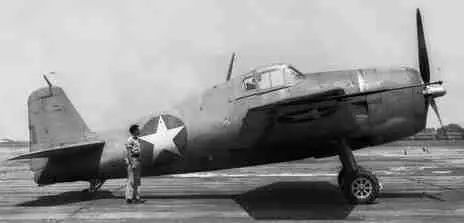|
THE GRUMMAN F6F HELLCAT  The famous Hellcat carrier based fighter was the follow on to Grumman's F4F Wildcat, which in the hands of hard pressed sailors and marines had probably been the most successful of the U.S. fighter planes striving to hold off the superior Japanese Zero. At the Battle of Midway, on Guadalcanal, and in other desperate places, the Wildcat pilots had given a good account of themselves. But there was no denying that their stubby fighter was inferior to the Zero in speed, climb, maneuverability, and range. Only in roll rate and dive speed did the Wildcat have an advantage, and it wasn't enough. The G-50 (as Grumman called it) Hellcat, designed in the Spring of 1942, reversed all of these deficiencies except range and climb. It was the only Allied fighter of the war that could dogfight with a Zero on fairly equal terms. In fact, even the Japanese admitted that the later model Hellcat could turn inside of the later model Zero at high speeds. Grumman achieved this by extremely clever design to reduce structural weight, and the use of the powerful Pratt and Whitney Double Wasp (2,000 hp.) 18 cylinder twin row radial engine, which greatly improved climb and acceleration compared to the earlier Wildcat. This engine drove a three bladed 13 ft. diameter Hamilton-Standard Hydromatic constant-speed propeller. The Hellcat was a low wing monoplane of all metal, flush riveted construction. Other improvements included armor protection for the pilot, wide-track landing gear that retracted hydraulically, hydraulically folding wings, and increased ammunition supply. The Hellcat had a longer and slimmer fuselage than its predecessor, and although similar in layout, it is not hard to tell the two apart. The Hellcat just looks like the higher performance aircraft it is. Like Grumman's previous Wildcat, the Hellcat's canopy design left a very large blind area astern. Grumman did not successfully address this flaw until the Hellcat was superceded by the F8F Bearcat. The prototype XF6F-1 first flew in August 1942. It was very successful, and was put into production as the F6F-3 by the end of that year. The F6F-3 first entered combat with the U. S. Fast Carrier Task Force in the raid on Marcus Island on September 1, 1943. From that time on, the Hellcat equipped fighter squadrons in the U. S. carrier air groups had the advantage over their Japanese adversaries. The F6F-3 was also supplied to the British Fleet Air Arm, as the Hellcat I. There was also a night fighter version with a wing mounted radar and a radio altimeter called the F6F-3N. Standard armament was 6-.50 cal. wing machine guns, and external loads of a 125 gal. drop tank, or up to 2-1,000 lb. bombs could be carried. Max. level speed was about 371 m.p.h. (see complete specifications below). The Hellcat bore the brunt of the later carrier battles that destroyed the legendary fast carrier task force of the Imperial Navy. The majority of top U.S.N. aces flew the Hellcat. The biggest carrier air battle of the war was the Battle of the Philippine Sea (or, as Navy aviators called it, "the Great Marianas Turkey shoot"), of 19-20 June 1944. In this battle, Hellcat fighters distinguished themselves. Total losses of American aircraft (of all types and from all causes) were 130, with 76 airmen killed. Total Japanese loss of aircraft amounted to about 480, with a similar number of airmen lost. In addition, the Japanese lost three large aircraft carriers. The power of the Japanese fast carrier task force was broken, never to be re-built. And the Hellcat fighter was king of the skies over the Pacific for the rest of the War. Specifications for the F6F-3 were as follows (from various
sources):
The follow on model was the F6F-5 Hellcat of 1944. The Fleet Air Arm version was called Hellcat II. Improvements included water injection for the engine, a redesigned engine cowling, new ailerons, improved windscreen, strengthened pilot armor, an autopilot, and a waxed high gloss finish. These changes cleaned up the aerodynamics somewhat, resulting in improved performance (speed now over 400 m.p.h., with improved maneuverability). The F6F-5 could carry drop tanks, bombs, or rockets externally. Most were armed with the standard 6-.50 cal. MG, but some late production airplanes were armed with 2-20mm cannon and 4-.50 cal. MG. Max. climb rate was now up to 3,000 ft./min., and max. range up to 1,800 miles with external fuel. Service ceiling was up to 37,800 ft. The F6F-5 was the final production version of the Hellcat. The Hellcat was the top scoring Allied Navy fighter of the war. Hellcat pilots shot down 4,947 enemy aircraft during World War II. All Hellcat production ceased in 1945, after approximately 12, 275 Hellcats had been produced. The F8F Bearcat superceded the Hellcat. The Bearcat related to the Hellcat in the same way that the Hellcat related to the Wildcat, and the Bearcat was the highest performance of all piston engine U.S.N. fighters. The war ended before it entered combat, and the jet age was just beginning. |